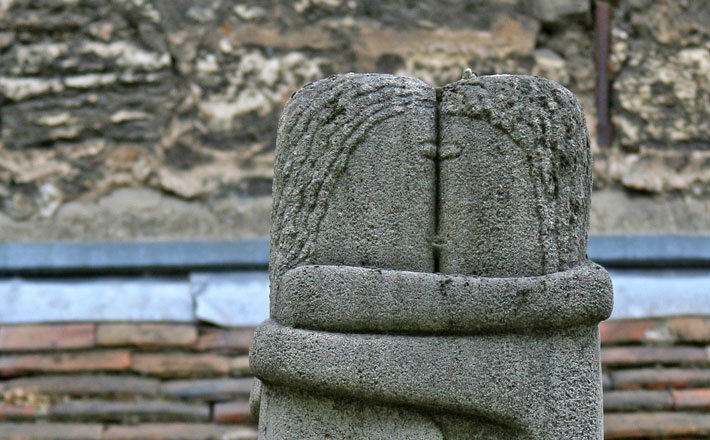Commentary on Isaiah 40:1-11
Verse 1, with its command to comfort the people of God, sets the tone not just for this passage but for the whole of Isaiah 40-66.
Prior to chapter 40 the news spoken in God’s name is a difficult word of judgment. The people have rebelled against God. The people have lived at the expense of their neighbors, putting their own desires above the needs of others. These chapters, mostly from the 8th century, point forward to a time when Jerusalem would be destroyed. In 587 BCE Jerusalem fell to Babylon, and a portion of Jerusalem’s population went into exile.
From chapter 40 forward, this word of judgment is in the past. Jerusalem was destroyed, and a number of its citizens did go into exile. Now, circa 540 BCE, on the other side of this experience, a new word comes to the people of Judah — a word of comfort and hope for a new future. Three proclamations build on the imperative to comfort God’s people in verse 1, each expanding on what it means for the people of Jerusalem to receive comfort.
A highway in the desert
While not everyone living in Jerusalem went into exile, a good number of people did. This passage heralds their return. The most direct route between Babylon and Judea, through the Syrian Desert, is poetically described in verse 3 as a way in the wilderness and a highway in the desert. It is unlikely, however, that any exiles returning from Babylon would have actually made the dangerous trek through the waterless wilderness. Rather, they would have followed water sources, arcing through northern Syria and then back south to Jerusalem.
That such a route would have been so unlikely suggests that a travel log is not the point. Rather, the poetic description functions to recall another journey through an inhospitable wilderness. This news of a metaphoric highway in the desert heralds a second Exodus, an easier one with flat ground and trouble-free travel (verse 4). Once more YHWH’s people would follow their God out of captivity to a Promised Land. Anyone who had doubted God’s presence in and devotion to Judah would see this and know that God had not only spoken a redeeming word but also had the power to fulfill it.
The word of our God stands forever
In verse 6 the punctuation marks in the NRSV communicate a short conversation between two voices. An anonymous voice, some sort of divine attendant, issues a command to “Cry out!” A second voice, “I,” asks what is to be cried. Following this terse dialogue is commentary on the poor, unreliable constancy of the people, liable to droop like a flower in a field, and a final, triumphant claim that God is wholly other — constant, reliable, and able to stand forever (vs. 6b-8). Punctuation marks, however, are decisions made by translators and interpreters. A number of scholars have suggested that the dialogue continues beyond the two lines shown in the NRSV.1 In this view, the “I,” speaking as the prophet, continues to speak to the end of verse 7. The words are an objection to the command to cry out. Why prophesy to a people with the constancy of grass? The anonymous voice responds in verse 8 with the very hopeful news that the constancy of the people is less important than that of God.
When read in this way, the passage echoes the pattern of a prophetic call narrative (introductory word, commissioning, objection, assurance) much like Isaiah’s call in Isaiah 6. This is a new word for a new time but is in line with the prophecy of Isaiah the 6th century prophet.
The objections of the prophet are understandable. Would the word fall on willing ears? Likely not. Would the message given make a difference in a world full of fickle people? Hard to tell. These are questions of most witnesses to the word and action of God, prophets and preachers included. The response that the word of God is not about human constancy but about the enduring reliability of God comes as assurance to prophets in this passage and to witnesses throughout the centuries.
Do not fear, oh Jerusalem, herald of good tidings
At the end of this passage the city of Jerusalem, also identified as Zion, is personified. This is a common trope in Isaiah 40-66 (cf 51:17-20; 52:1-2, 7-10; 54:1-17; 62:1-12). However, the place in the Old Testament in which Zion is personified most consistently is in the first two chapters of the book of Lamentations. In Lamentations 1-2 Daughter Zion cries out against the destruction wrought her. She speaks words of accusation against her human enemies and even God. The refrain that comes again and again is, “There is no one to comfort her” (Lamentations 1:2, 9, 16, 17, 21). At the end of her speeches — and even the end of the book of Lamentations — Daughter Zion receives no response to her cry.
The response to Zion’s laments comes, rather, in other biblical books. The response comes in verses such as Isaiah 40:1 “Comfort, O comfort my people.” The response comes in verses such as Isaiah 40:9 in which the words for Jerusalem to speak are not those of lament but of good news. She is no longer told to wail but to raise her voice without fear. The message given is confident and hopeful, “Here is your God!” Here is a God who comes to feed the flock, to gather the lambs, to lead the mother sheep — to bring comfort. Here is God in whom one may have hope.
Notes:
1 Christopher R. Seitz, “The Divine Council: Temporal Transition and New Prophecy in the Book of Isaiah,” Journal of Biblical Literature 109 (1990): 235; Brevard Childs, Isaiah: A Commentary (Louisville: Westminster John Knox, 2001), 300.


December 7, 2014